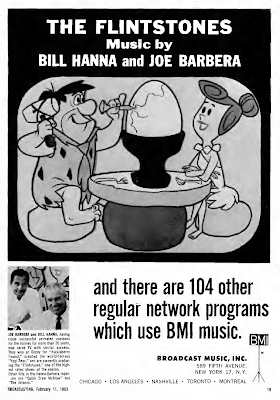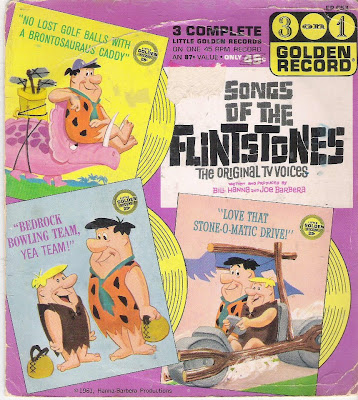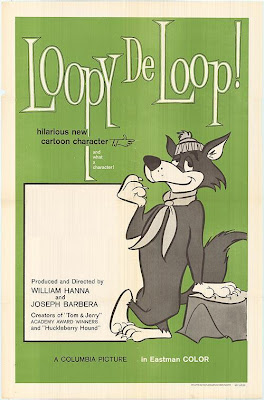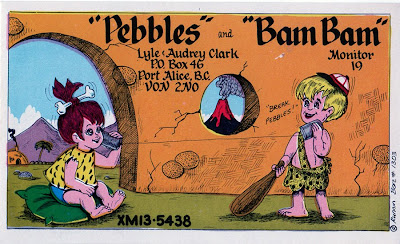Die-hard Hanna-Barbera fans have heard of—and maybe even seen—the 1970 summer replacement series “Where’s Huddles?” A similar question arises in thumbing through a 1963 edition of Broadcasting magazine—Where’s Hoyt?
![]()
Nowhere in the BMI ad above is there any mention of Hoyt Curtin, the man who wrote the music for Hanna-Barbera cartoons at the time this ad appeared. It’s not like Curtin’s music wasn’t licensed through BMI; a check of the company’s site finds 1,779 of Curtin’s works under its wing.
Curtin confirmed Bill Hanna wrote the lyrics to the earliest H-B theme songs. I’ve never figured out what Joe Barbera’s involvement was, other than listening to the songs, but he’s handed a composer credit through a number of publishing companies. Charlie Shows is also credited as a composer as well. Just not in the ad above, since he was a member of ASCAP. Shows’ ASCAP listing is a little curious. For example, he has a composer cue for “Bear on a Picnic.” There are no songs in the cartoon with that name and the only music is stock music. Perhaps he wrote continuity for a record of that cartoon.
Let us cleverly segue into the world of H-B characters on Little Golden Records and also into a thank-you to faithful Yowp readers who have passed on notes or pictures of items that would interest early Hanna-Barbera fans. Unfortunately, I can’t recall who sent everything. Sorry. Anyway, back to the records.
![]()
![]()
![]()
Hanna-Barbera had a few different record contracts before the H-B Records label was established in the mid-‘60s. One was Colpix, the record arm of Screen Gems, owned by Columbia Pictures, which partly bankrolled the cartoon studio when it began in 1957. Another was New York-based Golden Records, which put out kids’ 78s and 45s. We’ve linked before to some H-B tunes released by the company, but someone has sent along pictures of record sleeves.
What’s interesting is the Flintstones’ record advertises “The Original TV Voices.” The main problem with the Golden Records is Daws Butler was sewn up by Colpix so he was unable to voice characters for Golden. Hence some not-very-good Daws imitators were hired to play Yogi et al. You’ll notice the Huck cover says “Video Cartoon Voices,” which doesn’t categorically mean you’ll hear Daws or Don Messick on the sides. And the Quick Draw cover tells you in teeny-weeny letters that the voices are supplied by Gil Mack and Don Elliott. Thanks to this link via Andrew Morrice, you can hear how weak another member of the Golden stock company, Frank Milano, sounded as Hokey Wolf.
While we’re on the topic of weak, Scott Shaw passes on this very nice one-sheet for theatres that really wanted to promote Loopy De Loop cartoons on their screens.
![]()
I’m not a Loopy fan. Huck, Quick Draw and Yogi were far more likeable cartoon characters. Frankly, I’d rather watch Wally Gator, and the studio’s short cartoons were already sliding down hill by the time Wally came along in 1962. Loopy first appeared three years before that.
How was it that Columbia Pictures began distributing Loopy cartoons to begin with? I’d sure love to know what was in the bankrolling deal the movie studio had with Hanna-Barbera. It doesn’t seem like much of a stretch to conclude that someone like Columbia’s Harry Cohn barked “We own a cartoon studio. Why do we need to distribute those over-budget, artsy-schmartsy UPA cartoons anymore?” Cohn never seemed concerned about the quality of shorts so long as they were ground out on budget and, even if he was concerned, might have concluded that kids in theatres would accept limited animation just as they did on TV. It’s a real shame the H-B artists were saddled with Loopy instead of getting the money to do full personality animation on a new character with embellished sight gags like the kind Warren Foster and Mike Maltese wrote at Warners, with the score accenting and augmenting the artwork.
Columbia had released Scrappy cartoons some 25 years earlier. Scrappy’s biggest fan, Harry McCracken (note the segue again), has posted this interesting and, we suspect, home-made QSL card featuring Pebbles and Bamm Bamm from the ‘70s.
![]()
QSLs go back to the earliest days of radio when stations were experimental and listeners were hobbyists. A radiophile would tune in a station far away then send its engineers a reception report. The station would, in turn, reply with a thank-you postcard; some may still do it today. This card is for picking up some one’s CB radio transmissions from Port Alice, a somewhat remote mill town on Vancouver Island. Note the “Monitor 19” on the card. CBers generally use Channel 19 in Canada; some on the west coast use Channel 1. Chatting via CB and ham radio seems a little old-fashioned now, but you can meet some very genuine and friendly people that way.
Shortwave stations, too, sent QSL cards, like Italy’s RAI. And while we’re on the subject of Italian telecommunications (yeah, that segue is a real stretch), he’s something Charles Brubaker has discovered. It’s an Italian TV commercial from 1967 featuring Huckleberry Hound. Huck is known in Italy as “Broccobaldo.” I plugged the word into one of those Italian-to-English on-line translators to find out what it means. I got “Huckleberry Hound.” Therefore, I’m left to conclude the word didn’t exist before Huck’s creation in 1958.
Huck gains weight during the middle of the commercial, which has light backgrounds like a ’30s cartoon and some unidentified background music (besides the Huck theme).
Lest anyone think Huck is appearing as a twin in drag, Chris Sobieniak supplied this helpful information:
My thanks to the contributors to this post. Others have sent neat little things which will find their way into a future writing on this blog.

Nowhere in the BMI ad above is there any mention of Hoyt Curtin, the man who wrote the music for Hanna-Barbera cartoons at the time this ad appeared. It’s not like Curtin’s music wasn’t licensed through BMI; a check of the company’s site finds 1,779 of Curtin’s works under its wing.
Curtin confirmed Bill Hanna wrote the lyrics to the earliest H-B theme songs. I’ve never figured out what Joe Barbera’s involvement was, other than listening to the songs, but he’s handed a composer credit through a number of publishing companies. Charlie Shows is also credited as a composer as well. Just not in the ad above, since he was a member of ASCAP. Shows’ ASCAP listing is a little curious. For example, he has a composer cue for “Bear on a Picnic.” There are no songs in the cartoon with that name and the only music is stock music. Perhaps he wrote continuity for a record of that cartoon.
Let us cleverly segue into the world of H-B characters on Little Golden Records and also into a thank-you to faithful Yowp readers who have passed on notes or pictures of items that would interest early Hanna-Barbera fans. Unfortunately, I can’t recall who sent everything. Sorry. Anyway, back to the records.



Hanna-Barbera had a few different record contracts before the H-B Records label was established in the mid-‘60s. One was Colpix, the record arm of Screen Gems, owned by Columbia Pictures, which partly bankrolled the cartoon studio when it began in 1957. Another was New York-based Golden Records, which put out kids’ 78s and 45s. We’ve linked before to some H-B tunes released by the company, but someone has sent along pictures of record sleeves.
What’s interesting is the Flintstones’ record advertises “The Original TV Voices.” The main problem with the Golden Records is Daws Butler was sewn up by Colpix so he was unable to voice characters for Golden. Hence some not-very-good Daws imitators were hired to play Yogi et al. You’ll notice the Huck cover says “Video Cartoon Voices,” which doesn’t categorically mean you’ll hear Daws or Don Messick on the sides. And the Quick Draw cover tells you in teeny-weeny letters that the voices are supplied by Gil Mack and Don Elliott. Thanks to this link via Andrew Morrice, you can hear how weak another member of the Golden stock company, Frank Milano, sounded as Hokey Wolf.
While we’re on the topic of weak, Scott Shaw passes on this very nice one-sheet for theatres that really wanted to promote Loopy De Loop cartoons on their screens.

I’m not a Loopy fan. Huck, Quick Draw and Yogi were far more likeable cartoon characters. Frankly, I’d rather watch Wally Gator, and the studio’s short cartoons were already sliding down hill by the time Wally came along in 1962. Loopy first appeared three years before that.
How was it that Columbia Pictures began distributing Loopy cartoons to begin with? I’d sure love to know what was in the bankrolling deal the movie studio had with Hanna-Barbera. It doesn’t seem like much of a stretch to conclude that someone like Columbia’s Harry Cohn barked “We own a cartoon studio. Why do we need to distribute those over-budget, artsy-schmartsy UPA cartoons anymore?” Cohn never seemed concerned about the quality of shorts so long as they were ground out on budget and, even if he was concerned, might have concluded that kids in theatres would accept limited animation just as they did on TV. It’s a real shame the H-B artists were saddled with Loopy instead of getting the money to do full personality animation on a new character with embellished sight gags like the kind Warren Foster and Mike Maltese wrote at Warners, with the score accenting and augmenting the artwork.
Columbia had released Scrappy cartoons some 25 years earlier. Scrappy’s biggest fan, Harry McCracken (note the segue again), has posted this interesting and, we suspect, home-made QSL card featuring Pebbles and Bamm Bamm from the ‘70s.

QSLs go back to the earliest days of radio when stations were experimental and listeners were hobbyists. A radiophile would tune in a station far away then send its engineers a reception report. The station would, in turn, reply with a thank-you postcard; some may still do it today. This card is for picking up some one’s CB radio transmissions from Port Alice, a somewhat remote mill town on Vancouver Island. Note the “Monitor 19” on the card. CBers generally use Channel 19 in Canada; some on the west coast use Channel 1. Chatting via CB and ham radio seems a little old-fashioned now, but you can meet some very genuine and friendly people that way.
Shortwave stations, too, sent QSL cards, like Italy’s RAI. And while we’re on the subject of Italian telecommunications (yeah, that segue is a real stretch), he’s something Charles Brubaker has discovered. It’s an Italian TV commercial from 1967 featuring Huckleberry Hound. Huck is known in Italy as “Broccobaldo.” I plugged the word into one of those Italian-to-English on-line translators to find out what it means. I got “Huckleberry Hound.” Therefore, I’m left to conclude the word didn’t exist before Huck’s creation in 1958.
Huck gains weight during the middle of the commercial, which has light backgrounds like a ’30s cartoon and some unidentified background music (besides the Huck theme).
Lest anyone think Huck is appearing as a twin in drag, Chris Sobieniak supplied this helpful information:
"Actually the girl is Huck´s girlfriend, Kitty, and the puppy is his nephew. These characters never appeared in Huck´s American cartoons or comic books; instead, they appeared in Italian comics with material featuring the Hanna-Barbera characters. drawn by local artists. In his Italian stories, Huck even had a mean grouchy grandpa, mirroring Donald Duck´s relationship with Uncle Scrooge. Oh, and the mole appearing at the beginning had originally appeared in one of Huck's comic books published in the early 60´s by Dell, in a story drawn by Harvey Eisenberg."You’d think his girl-friend would be named Clementine.
My thanks to the contributors to this post. Others have sent neat little things which will find their way into a future writing on this blog.